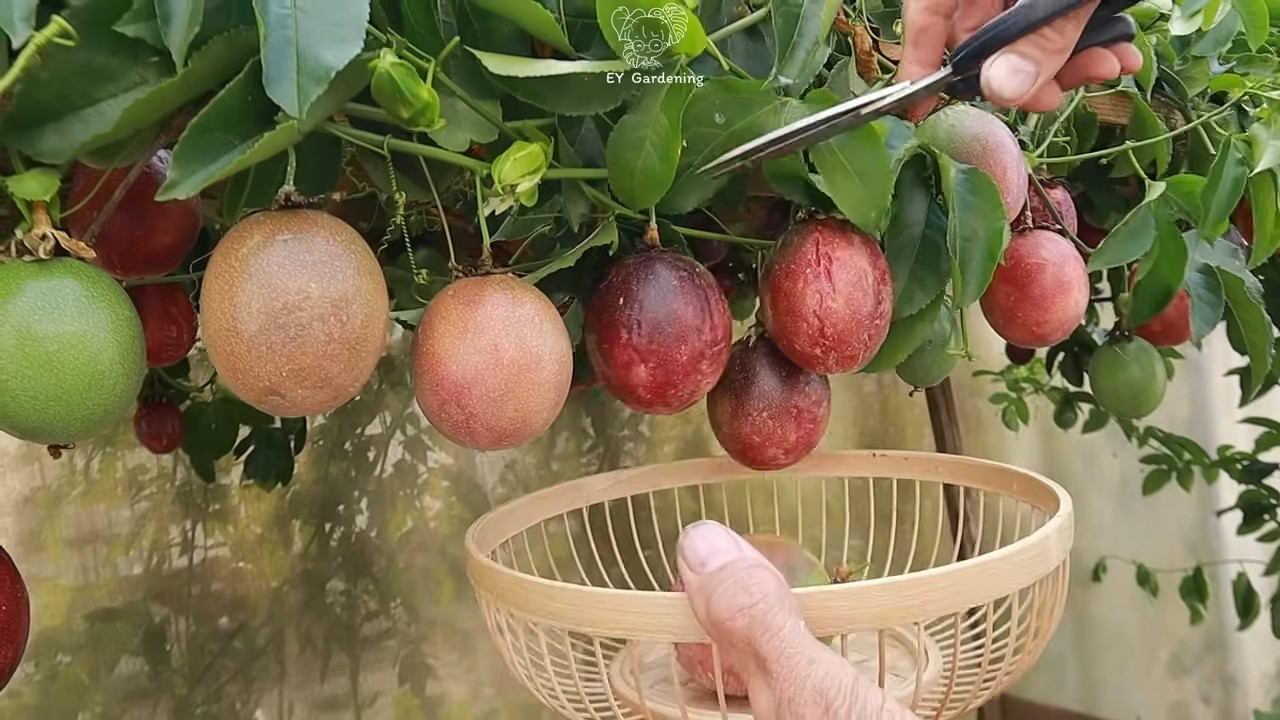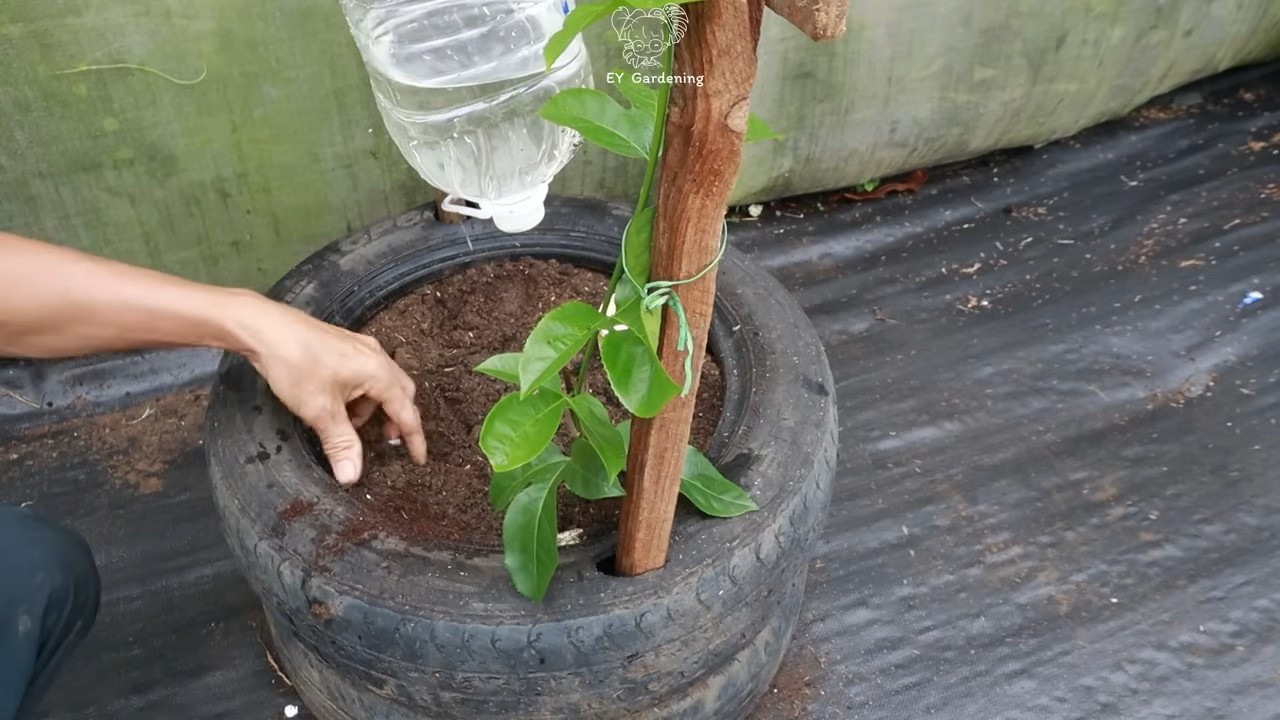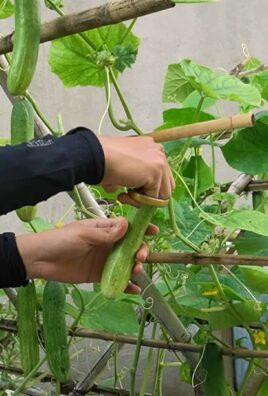Grow Passion Fruit at Home and transform your backyard into a tropical paradise! Imagine stepping outside and plucking a perfectly ripe, tangy-sweet passion fruit straight from your own vine. Sounds dreamy, right? Well, it’s more achievable than you might think, and I’m here to show you how with some simple DIY tricks and hacks.
Passion fruit, with its vibrant flavor and exotic aroma, has a rich history rooted in South America, where indigenous cultures have cultivated it for centuries. It wasn’t just a delicious treat; it held cultural significance, often used in traditional medicines and ceremonies. Now, its popularity has spread worldwide, and thankfully, you don’t need a tropical climate to enjoy its bounty.
Why bother learning how to grow passion fruit at home? Simple! Store-bought passion fruit can be expensive and often lacks the intense flavor of homegrown varieties. Plus, there’s nothing quite like the satisfaction of nurturing a plant from seedling to fruit-bearing vine. I’ll guide you through selecting the right variety for your climate, preparing the perfect soil, and even creating a DIY trellis system to support your growing vine. Get ready to impress your friends and family with your green thumb and enjoy a taste of the tropics right in your own backyard!

Grow Your Own Passion Fruit Paradise: A DIY Guide
Hey there, fellow plant enthusiasts! Ever dreamed of plucking a juicy, fragrant passion fruit straight from your own vine? Well, dream no more! Growing passion fruit at home is totally achievable, and I’m here to walk you through every step of the process. It might seem a little daunting at first, but trust me, with a little patience and the right know-how, you’ll be enjoying homegrown passion fruit in no time.
Choosing Your Passion Fruit Variety
Before we dive into the nitty-gritty, let’s talk about varieties. Not all passion fruit are created equal! Some are better suited for certain climates, and some have different flavor profiles. Here’s a quick rundown of some popular choices:
* Purple Passion Fruit (Passiflora edulis): This is probably the most common variety you’ll find. It’s known for its tart, aromatic flavor and is relatively cold-hardy.
* Yellow Passion Fruit (Passiflora edulis flavicarpa): This variety is typically larger and more acidic than the purple passion fruit. It’s also more vigorous and disease-resistant, making it a good choice for beginners.
* Sweet Granadilla (Passiflora ligularis): If you prefer a sweeter, less acidic flavor, this is the one for you! It’s also known for its beautiful flowers.
* Hybrid Varieties: There are also many hybrid varieties available that combine the best traits of different species. Do some research to see what’s available in your area and what flavors appeal to you most.
Important Note: When choosing your variety, consider your local climate. Some passion fruit varieties are more tolerant of cold weather than others. If you live in an area with harsh winters, you might need to grow your passion fruit in a container so you can bring it indoors during the colder months.
Getting Started: From Seed or Cutting?
You have two main options for starting your passion fruit journey: from seed or from cutting. Each method has its pros and cons:
* Starting from Seed: This is the more economical option, but it can be a bit slower. Seeds can take several weeks to germinate, and it can take a few years for the plant to mature and produce fruit.
* Starting from Cutting: This is a faster way to get a fruiting plant, as you’re essentially cloning an existing plant. Cuttings will typically root within a few weeks, and you can expect to see fruit sooner than with seeds.
For this guide, I’ll focus on starting from seed, as it’s the more common method for home gardeners.
Phase 1: Germinating Your Passion Fruit Seeds
Okay, let’s get those seeds sprouting! Here’s what you’ll need:
* Passion fruit seeds (fresh seeds are best!)
* Small pots or seed trays
* Seed-starting mix (a light, well-draining mix is crucial)
* A warm, sunny location (or a grow light)
* A spray bottle
Step-by-Step Instructions:
1. Prepare Your Seeds: Passion fruit seeds have a hard outer coating that can make germination difficult. To help them sprout, you can try scarifying them. Gently rub the seeds with sandpaper or soak them in warm water for 24-48 hours. This helps to break down the seed coat and allows water to penetrate.
2. Fill Your Pots: Fill your small pots or seed trays with seed-starting mix. Moisten the mix thoroughly, but don’t let it get soggy.
3. Sow the Seeds: Sow the seeds about 1/2 inch deep in the soil. Place 2-3 seeds in each pot to increase your chances of success.
4. Water Gently: Gently water the seeds with a spray bottle to avoid disturbing them.
5. Create a Humid Environment: Cover the pots with plastic wrap or a humidity dome to create a warm, humid environment. This will help the seeds germinate.
6. Provide Warmth and Light: Place the pots in a warm, sunny location or under a grow light. Passion fruit seeds need warmth to germinate, ideally between 70-80°F (21-27°C).
7. Be Patient: Germination can take anywhere from 2-8 weeks, so be patient! Keep the soil moist but not soggy, and check the pots regularly for signs of sprouting.
8. Remove the Cover: Once the seedlings emerge, remove the plastic wrap or humidity dome.
Phase 2: Transplanting Your Seedlings
Once your seedlings have developed a few sets of true leaves (the leaves that look like miniature versions of the adult leaves), it’s time to transplant them into larger pots.
What You’ll Need:
* Larger pots (at least 6 inches in diameter)
* Potting mix (a well-draining mix is still important)
* A trowel
* Water
Step-by-Step Instructions:
1. Prepare the Pots: Fill the larger pots with potting mix.
2. Gently Remove the Seedlings: Carefully remove the seedlings from their small pots, being careful not to damage the roots. You might need to gently loosen the soil around the roots with a trowel.
3. Transplant the Seedlings: Plant each seedling in its own pot, making sure the top of the root ball is level with the soil surface.
4. Water Thoroughly: Water the seedlings thoroughly after transplanting.
5. Provide Support: As the seedlings grow, they will need support. You can use small stakes or trellises to help them climb.
Phase 3: Caring for Your Passion Fruit Vine
Now that your passion fruit vine is growing, it’s time to provide it with the care it needs to thrive.
Sunlight: Passion fruit vines need at least 6-8 hours of sunlight per day. If you’re growing your vine indoors, make sure it’s in a sunny window or under a grow light.
Watering: Water your passion fruit vine regularly, especially during hot, dry weather. The soil should be kept moist but not soggy. Overwatering can lead to root rot.
Fertilizing: Feed your passion fruit vine with a balanced fertilizer every few weeks during the growing season. Look for a fertilizer that’s specifically formulated for flowering plants.
Pruning: Pruning is essential for keeping your passion fruit vine healthy and productive. Prune the vine regularly to remove dead or damaged growth and to encourage branching. You can also prune the vine to control its size and shape.
Support: Passion fruit vines are climbers, so they need a strong support structure. You can use a trellis, fence, or arbor to support your vine. Make sure the support structure is sturdy enough to handle the weight of the vine and its fruit.
Pest and Disease Control: Passion fruit vines can be susceptible to pests and diseases. Keep an eye out for common pests like aphids, spider mites, and scale. Treat any infestations promptly with insecticidal soap or neem oil. Prevent fungal diseases by providing good air circulation and avoiding overwatering.
Pollination: Passion fruit flowers are typically pollinated by bees and other insects. If you’re growing your vine indoors, you may need to hand-pollinate the flowers. Use a small paintbrush to transfer pollen from the stamen (the male part of the flower) to the pistil (the female part of the flower).
Phase 4: Harvesting Your Passion Fruit
After all your hard work, the moment you’ve been waiting for has finally arrived: harvesting your passion fruit!
When to Harvest: Passion fruit are ripe when they change color and fall from the vine. The skin will also become slightly wrinkled.
How to Harvest: Simply pick up the fallen fruit from the ground. If the fruit doesn’t fall easily, it’s not quite ripe yet.
Enjoying Your Harvest: Passion fruit can be eaten fresh, or used in a variety of recipes. The pulp can be scooped out and eaten with a spoon, or added to smoothies, juices, and desserts. The juice can also be used to make jams, jellies, and sauces.
Troubleshooting Common Problems
Even with the best care, you might encounter some problems along the way. Here are a few common issues and how to address them:
* Yellowing Leaves: This could be a sign of overwatering, nutrient deficiency, or pest infestation. Check the soil moisture, fertilize the vine, and inspect it for pests.
* Lack of Flowers: This could be due to insufficient sunlight, improper fertilization, or pruning at the wrong time. Make sure the vine is getting enough sunlight, fertilize it with a fertilizer that’s high in phosphorus, and avoid pruning during the flowering season.
* Fruit Drop: This could be caused by poor pollination, insufficient watering, or extreme temperatures. Hand-pollinate the flowers, water the vine regularly, and protect it from extreme temperatures.
* Pest Infest

Conclusion
So, there you have it! Growing passion fruit at home isn’t just a whimsical gardening dream; it’s an achievable reality with the right knowledge and a little dedication. We’ve walked you through the essential steps, from selecting the perfect variety to nurturing your vine to its full, fruit-bearing potential. But why should you embark on this journey?
Firstly, the taste. Forget the bland, mass-produced passion fruit you find in supermarkets. Homegrown passion fruit bursts with an unparalleled tropical sweetness and tangy aroma that will elevate your desserts, drinks, and even savory dishes to a whole new level. Imagine the satisfaction of plucking a perfectly ripe fruit, knowing you nurtured it from a tiny seed or cutting. That’s a reward in itself.
Secondly, it’s a sustainable and cost-effective way to enjoy this exotic fruit. Instead of relying on imported produce, you can have a continuous supply right in your backyard, reducing your carbon footprint and saving money in the long run. Plus, the vibrant green foliage and fragrant flowers of the passion fruit vine will add a touch of tropical elegance to your garden, making it a visually stunning and aromatic addition to your outdoor space.
But the benefits extend beyond taste and sustainability. Gardening, in general, is a fantastic stress reliever and a great way to connect with nature. Tending to your passion fruit vine can be a meditative and rewarding experience, providing a sense of accomplishment as you watch it grow and flourish.
Ready to take your passion fruit cultivation to the next level? Consider these variations:
* Experiment with different varieties: Explore the diverse world of passion fruit, from the classic purple to the golden yellow and even the giant granadilla. Each variety offers a unique flavor profile and growth habit, so find the one that best suits your taste and climate.
* Vertical gardening: If you have limited space, train your passion fruit vine to grow vertically on a trellis, fence, or even a balcony railing. This not only saves space but also creates a stunning green wall that adds privacy and beauty to your outdoor area.
* Grafting for enhanced resilience: For those in colder climates, consider grafting your desired passion fruit variety onto a more cold-hardy rootstock. This can significantly improve the plant’s ability to withstand frost and low temperatures.
* Passion Fruit Vine Propagation: Propagate new vines from cuttings of your existing plant. This is a cost-effective way to expand your passion fruit collection or share your passion with friends and family.
We’ve provided you with the tools and knowledge to successfully grow passion fruit at home. Now, it’s your turn to put them into practice. Don’t be afraid to experiment, learn from your mistakes, and adapt your approach to suit your specific environment and preferences.
We are confident that you’ll find the experience incredibly rewarding. So, grab your gardening gloves, select your passion fruit variety, and get ready to embark on a tropical adventure right in your own backyard.
And most importantly, we want to hear about your journey! Share your experiences, successes, and challenges in the comments below. Let’s create a community of passionate passion fruit growers and learn from each other. Happy gardening!
Frequently Asked Questions (FAQs)
What is the best climate for growing passion fruit?
Passion fruit thrives in warm, subtropical to tropical climates. Ideally, temperatures should range between 65°F (18°C) and 85°F (29°C). While they can tolerate brief periods of cooler temperatures, prolonged exposure to frost can damage or kill the plant. If you live in a colder climate, consider growing passion fruit in a container that can be moved indoors during the winter months. Selecting a cold-hardy variety or grafting onto a cold-hardy rootstock can also improve its chances of survival in cooler regions. Remember to provide adequate sunlight, even indoors, using grow lights if necessary.
How much sunlight does passion fruit need?
Passion fruit vines require at least 6-8 hours of direct sunlight per day to produce abundant fruit. Insufficient sunlight can result in poor flowering and reduced fruit production. Choose a planting location that receives full sun exposure throughout the day. If you’re growing passion fruit indoors, place it near a sunny window or supplement with artificial grow lights. Rotate the plant regularly to ensure even light exposure on all sides.
What type of soil is best for passion fruit?
Passion fruit prefers well-draining soil that is rich in organic matter. The ideal soil pH is between 6.0 and 7.5. Avoid heavy clay soils that retain too much moisture, as this can lead to root rot. Amend the soil with compost, aged manure, or other organic materials to improve drainage and fertility. You can also grow passion fruit in raised beds or containers filled with a high-quality potting mix. Regular soil testing can help you determine if any nutrient deficiencies need to be addressed.
How often should I water my passion fruit vine?
Water passion fruit vines regularly, especially during hot, dry weather. Keep the soil consistently moist but not waterlogged. Overwatering can lead to root rot, while underwatering can stress the plant and reduce fruit production. Water deeply and thoroughly, allowing the water to penetrate the root zone. Reduce watering during the winter months when the plant is less active. Mulching around the base of the vine can help retain moisture and suppress weeds.
When does passion fruit typically flower and fruit?
Passion fruit typically flowers in the spring and summer, and the fruit ripens 70-80 days after pollination. The exact timing can vary depending on the climate, variety, and growing conditions. In warmer climates, passion fruit may flower and fruit year-round. To encourage flowering, ensure the plant receives adequate sunlight, water, and nutrients. Pruning the vine after fruiting can also promote new growth and flowering in the following season.
How do I pollinate passion fruit flowers?
Passion fruit flowers are typically pollinated by insects, such as bees and butterflies. However, in some cases, hand-pollination may be necessary to ensure fruit set. This is especially true if you’re growing passion fruit indoors or in an area with limited pollinator activity. To hand-pollinate, use a small paintbrush to transfer pollen from the anthers (male parts) of one flower to the stigma (female part) of another flower. Do this in the morning when the flowers are open and the pollen is fresh.
What are some common pests and diseases that affect passion fruit?
Passion fruit can be susceptible to various pests and diseases, including aphids, spider mites, scale insects, and fungal diseases like fusarium wilt and root rot. Regularly inspect your vine for signs of infestation or disease. Treat any problems promptly with appropriate organic or chemical controls. Good cultural practices, such as proper watering, fertilization, and pruning, can help prevent many pest and disease problems.
How do I prune my passion fruit vine?
Pruning is essential for maintaining the health and productivity of your passion fruit vine. Prune the vine after fruiting to remove dead, damaged, or overcrowded growth. This will encourage new growth and flowering in the following season. Also, prune any suckers that emerge from the base of the plant. Train the vine to grow along a trellis or other support structure by selectively pruning the lateral branches. Avoid heavy pruning, as this can reduce fruit production.
How long does it take for a passion fruit vine to produce fruit?
Passion fruit vines typically start producing fruit within 1-2 years of planting, depending on the variety and growing conditions. Seedlings may take longer to fruit than plants propagated from cuttings. To encourage early fruiting, provide the vine with optimal growing conditions, including plenty of sunlight, water, and nutrients. Pruning the vine regularly can also promote earlier fruit production.
Can I grow passion fruit in a container?
Yes, passion fruit can be successfully grown in containers, especially in colder climates where the plant needs to be moved indoors during the winter. Choose a large container with good drainage and fill it with a high-quality potting mix. Provide the vine with a trellis or other support structure to climb on. Water and fertilize the plant regularly, and protect it from frost and extreme temperatures. Container-grown passion fruit may require more frequent watering and fertilization than plants grown in the ground.





Leave a Comment